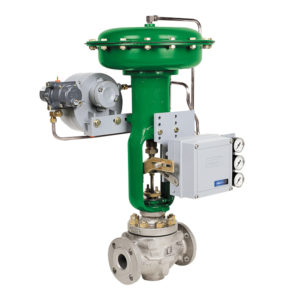Executive summary
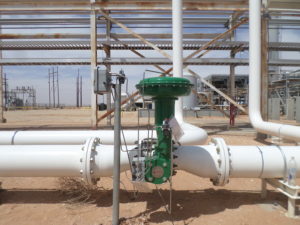 Oil producer Trinity EOR was regularly experiencing unplanned downtime and lost productivity because the control valves on their inlet lines couldn’t keep their compressors from overloading. Several vendors had attempted to solve the problem without success.
Oil producer Trinity EOR was regularly experiencing unplanned downtime and lost productivity because the control valves on their inlet lines couldn’t keep their compressors from overloading. Several vendors had attempted to solve the problem without success.
Automation Service analyzed the plant’s operations to diagnose the problem. They installed remanufactured controllers with Proportional + Reset control, remanufactured positioners, and a remanufactured actuator. They then ran multiple pressure excursion scenarios to tune and optimize the control loops.
Since the work was performed, Trinity EOR hasn’t experienced a recurrence of the problem. They’ve been able to increase the operating pressure and boost unit productivity without any compressors going down.
The challenge: Control valves on the supply lines were not providing adequate control to keep compressors from overloading
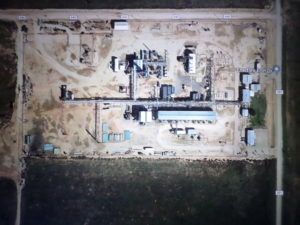 West Texas oil producer Trinity EOR uses CO2 to produce hard-to-reach oil. After the CO2 is used, it’s gathered, scrubbed of other gasses, and recycled so it can be sent back to the oil field for reuse. In this system, the more CO2 that can be processed in a facility, the more oil the unit can produce.
West Texas oil producer Trinity EOR uses CO2 to produce hard-to-reach oil. After the CO2 is used, it’s gathered, scrubbed of other gasses, and recycled so it can be sent back to the oil field for reuse. In this system, the more CO2 that can be processed in a facility, the more oil the unit can produce.
However, the plant had been experiencing problems achieving good compressor suction control. The inlet control valve on the supply lines wasn’t effectively keeping the compressors from overloading and shutting down. To compensate, Trinity EOR was using supply line vent valves as control elements. As a result, they had to operate the facility at a lower pressure, which meant lower productivity.
Even with the reduced operating pressure, the compressors would overload and shut down six to eight times a year, especially in warmer seasonal temperatures. This created challenges for the plant’s small staff. “With only three on-site employees, we had to be very conservative,” said Buddy Dickson, the facility’s construction and maintenance supervisor. “When a machine goes down, you may not lose just one machine. It may create a domino effect, which is a major problem. If a shutdown happens during the day, it may impact production for an hour. But if it’s in the middle of the night, when no one’s on site, it can be two to three hours before we have it back up and running.”
It was a problem Trinity EOR was eager to solve. Without an I&E technician on staff, they relied on outside contractors, and they’d had at least half a dozen different providers come out to examine their process and implement solutions. In total, Dickson estimates that the company had spent roughly $20,000 on new equipment and service, but the compressors continued to overload and impact plant performance.
The solution: Automation Service replaced Proportional Only controllers with Proportional + Reset controllers, resized a valve actuator, installed valve positioners, and optimized the control loops
Dickson contacted Automation Service, which he’d heard about from a distributor. Jerry Butz, Automation Service’s Director of Engineering and Technical Support, led the project through three phases: discovery, implementation, and optimization.
Phase 1: Discovery
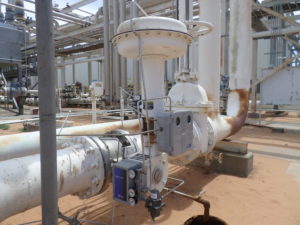 The first thing Butz did was to make sure he fully understood the problem. Butz and his team analyzed descriptions of every package Trinity EOR had in the field to gain a big-picture view of the plant’s operations.
The first thing Butz did was to make sure he fully understood the problem. Butz and his team analyzed descriptions of every package Trinity EOR had in the field to gain a big-picture view of the plant’s operations.
After reviewing all aspects and specifications of the controls, Butz concluded that the equipment was measuring the pressure accurately, but that it wasn’t providing proper output to the control valves to match the actual pressure to the setpoint. He identified three equipment changes to bridge this gap:
- Replace the existing Proportional Only controllers with Proportional + Reset controllers. Proportional + Reset control provides a more sophisticated response to pressure changes.
- Replace an undersized actuator. The actuator on one of the supply line valves was undersized, resulting in a sluggish response.
- Install valve positioners on the control valves. Valve positioners improve the performance of control valves by providing more accurate control and a faster response.
“This is where everyone else fell short. They didn’t work to completely understand the problem before they tried to fix it. Automation Service spent the time to discover why the compressors were going down.” ~Buddy Dickson, Trinity EOR
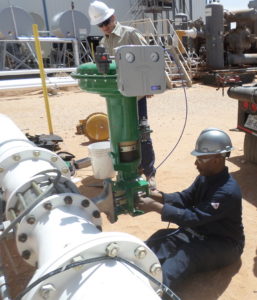 Phase 2: Implementation
Phase 2: Implementation
First, the Automation Service team replaced the existing Proportional Only pneumatic pressure controllers on both supply lines with remanufactured Fisher® 4160 Proportional + Reset controllers. The controller calibration range was also re-scaled from 0-600 psi to 0-200 psi to increase the pressure control accuracy.
Next, they replaced the Fisher 1051/60 actuator on one of the valves with a remanufactured Fisher 1052/70, which is larger. The properly sized actuator allows the valve to achieve its desired position much faster.
Finally, they installed remanufactured Fisher 3610J pneumatic valve positioners on both inlet control valves to boost their performance.
“Automation Service covered every base. The process went as smoothly as possible.” ~Manufacturer’s representative
Phase 3: Optimization
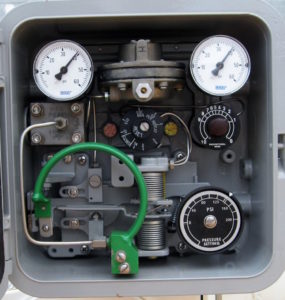 On Days 2 and 3, Automation Service tested and optimized the inlet supply line and supply vent control loops by running various pressure excursion scenarios and adjusting controller tuning parameters. “At the end of the day, it doesn’t matter if you’ve got well-built equipment. If it’s not specified properly, set up properly, and tuned properly, it won’t provide the functionality today’s plants require,” Butz says.
On Days 2 and 3, Automation Service tested and optimized the inlet supply line and supply vent control loops by running various pressure excursion scenarios and adjusting controller tuning parameters. “At the end of the day, it doesn’t matter if you’ve got well-built equipment. If it’s not specified properly, set up properly, and tuned properly, it won’t provide the functionality today’s plants require,” Butz says.
To test the equipment, Automation Service raised and lowered the pressure, took wells on- and offline, shut down machines, and so on. The goal was to make sure the equipment would respond appropriately in both normal and abnormal operating conditions, including pressure drops and surges.
Through this process, Automation Service was able to optimize the control loops to control the pressure within 5 psi of the setpoint.
“Automation Service put the plant through its paces. None of the previous suppliers we’d worked with had taken the time to do this. They even finished early and performed another job for us as well.” ~Buddy Dickson, Trinity EOR
The results: Trinity EOR has not had a compressor go down since the project was completed
By installing new process control equipment and optimizing the control loops, Automation Service solved the problem. No machine has gone down since the work was completed. What’s more, Trinity EOR has been able to raise the operating pressure and increase production at the plant.
“We’ve been able to raise the vent controllers to get deadband between the point where the inlet controllers start controlling and the point where the vent valves start operating,” Dickson said. “We now have a gap in which we can operate without worrying about our compressors going down.”
“The equipment Automation Service installed does exactly what it’s supposed to do. We haven’t looked back.” ~Buddy Dickson, Trinity EOR
______________________________
Do you have a process control issue that’s costing you money and decreasing your productivity? Get in touch with our team of experts.

